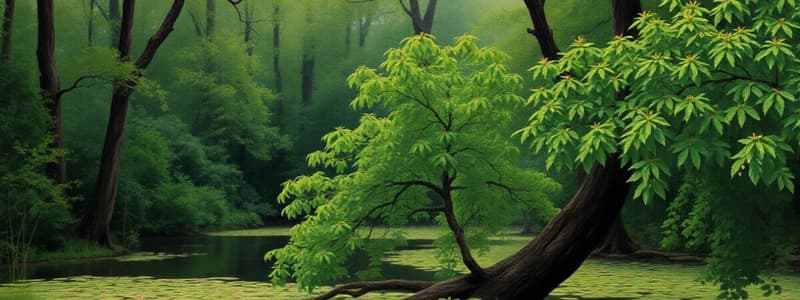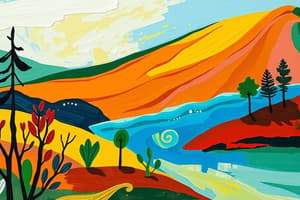Podcast
Questions and Answers
What does carrying capacity refer to in an ecosystem?
What does carrying capacity refer to in an ecosystem?
- The range of temperatures a species can withstand
- The genetic diversity within a population
- The maximum population size that an ecosystem can sustain (correct)
- The total amount of resources available in an area
Which of the following accurately describes mutualism?
Which of the following accurately describes mutualism?
- Both species benefit from the relationship (correct)
- One species benefits at the expense of another
- Both species compete for the same resources
- One species is neither helped nor harmed by the interaction
What is the primary factor that alters an ecosystem's carrying capacity?
What is the primary factor that alters an ecosystem's carrying capacity?
- Population density
- Natural disasters
- Habitat fragmentation
- Human activities (correct)
In terms of ecological relationships, what characterizes parasitism?
In terms of ecological relationships, what characterizes parasitism?
Which of the following statements about the nitrogen cycle is correct?
Which of the following statements about the nitrogen cycle is correct?
What term describes organisms that must eat other organisms to obtain energy?
What term describes organisms that must eat other organisms to obtain energy?
What are the main factors that determine population size?
What are the main factors that determine population size?
Which of the following statements about ecological niches is true?
Which of the following statements about ecological niches is true?
What is a community in ecological terms?
What is a community in ecological terms?
Which type of species has a disproportionately large impact on its ecosystem?
Which type of species has a disproportionately large impact on its ecosystem?
During which cycle is carbon primarily cycled through different environmental spheres?
During which cycle is carbon primarily cycled through different environmental spheres?
What primarily drives exponential growth in a population?
What primarily drives exponential growth in a population?
Which describes the role of ecosystem engineers?
Which describes the role of ecosystem engineers?
What is the primary role of autotrophs in an ecosystem?
What is the primary role of autotrophs in an ecosystem?
Which of the following is a characteristic of the lithosphere?
Which of the following is a characteristic of the lithosphere?
What defines a trophic level?
What defines a trophic level?
Which statement accurately describes sustainability?
Which statement accurately describes sustainability?
What can be inferred about the relationship between biotic and abiotic components in an ecosystem?
What can be inferred about the relationship between biotic and abiotic components in an ecosystem?
What is one reason why trophic efficiency is always less than 100%?
What is one reason why trophic efficiency is always less than 100%?
Which of the following represents a biotic factor in an ecosystem?
Which of the following represents a biotic factor in an ecosystem?
Why are migrant species important to ecosystems?
Why are migrant species important to ecosystems?
Which abiotic factor is characteristic of the tundra biome?
Which abiotic factor is characteristic of the tundra biome?
What is a common biotic component found in a mountain forest?
What is a common biotic component found in a mountain forest?
Which of the following is NOT an abiotic factor of the grassland biome?
Which of the following is NOT an abiotic factor of the grassland biome?
In what kind of forest would you expect to find trees shedding their leaves annually?
In what kind of forest would you expect to find trees shedding their leaves annually?
Which biome has the highest average annual precipitation?
Which biome has the highest average annual precipitation?
What describes the soil quality of the tundra biome?
What describes the soil quality of the tundra biome?
Which animal is associated with the boreal forest biome?
Which animal is associated with the boreal forest biome?
Which biome is characterized by having no permafrost?
Which biome is characterized by having no permafrost?
What is a defining feature of oligotrophic freshwater ecosystems?
What is a defining feature of oligotrophic freshwater ecosystems?
Which species is commonly found in grassland ecosystems?
Which species is commonly found in grassland ecosystems?
What defines a biome?
What defines a biome?
What is the main role of producers in an ecosystem?
What is the main role of producers in an ecosystem?
Which of the following best describes a food web?
Which of the following best describes a food web?
What is the role of decomposers in an ecosystem?
What is the role of decomposers in an ecosystem?
What does the term 'trophic level' refer to?
What does the term 'trophic level' refer to?
Which process converts sunlight into chemical energy?
Which process converts sunlight into chemical energy?
Which of the following describes mutualism?
Which of the following describes mutualism?
What are abiotic factors in an ecosystem?
What are abiotic factors in an ecosystem?
How does deforestation impact atmospheric conditions?
How does deforestation impact atmospheric conditions?
Which cycle involves the movement of nitrogen through living organisms and the environment?
Which cycle involves the movement of nitrogen through living organisms and the environment?
Flashcards are hidden until you start studying
Study Notes
The Spheres of Earth
- Biosphere: Zone around Earth where life exists
- Atmosphere: Layer of gases surrounding Earth
- Lithosphere: Earth's solid outer layer
- Hydrosphere: All of Earth's water in solid, liquid, and gas forms
Sustainability
- Biotic: Living parts of an ecosystem (eg. moose)
- Abiotic: Non-living parts of an ecosystem (eg. rocky cliffs)
- Ecosystem: Interacting parts of a biological community and its environment (living things and their environment)
- Sustainability: Ability to be maintained at a certain rate or level
Trophic Levels, Diets and Contaminants
- Trophic level: Category of organisms based on how they gain energy
- Autotroph: Organisms that create complex organic compounds from simple nutrients, often using sunlight (they make their own food)
- Heterotroph: Organisms that consume organic material to produce energy
- Trophic efficiency: The amount of energy or biomass transferred up trophic levels (always less than 100% due to energy loss during processes like hunting and digestion)
- Producer: Organisms that make their own food (eg. autotrophs)
- Consumer: Organisms that must eat other organisms for energy
Populations, Communities & Interactions
- Population: All individuals of a species in a given geographical area at a particular time
- Factors affecting population size: Natality (birth rate), immigration, fatality (death rate), emigration
- Interspecies interactions: Interactions between species that can have positive or negative effects on populations
- Ecological niche: The role an organism plays in an ecosystem (what it eats, what eats it, and its behavior)
- Predation & population size: Predator and prey populations influence each other
Communities
- Community: A group of different species occupying the same geographical area at a specific time
- Dominant species: Species with a large effect on the community
- Keystone species: Species with a disproportionately large impact on the community, often affecting many other species
- Ecosystem engineers: Species that create or modify habitats for other species
Cycles
- Biogeochemical cycles: Movement of matter through the biotic and abiotic environment
- Water cycle: Cycling of water through the environment (most water is in the abiotic environment)
- Carbon cycle: Cycling of carbon through the lithosphere, atmosphere, hydrosphere, and biosphere
- Carbon deposits: Fossil fuels (coal, oil, natural gas), oil shale, carbonate-based sedimentary deposits (limestone)
- Human impact on carbon cycle: Burning fossil fuels, land-use change, using limestone for concrete
- Nitrogen Cycle: Moving nitrogen compounds through biotic and abiotic environment
Carrying Capacity & Tolerance Range, 5 Types of Ecological Relationships
- Carrying capacity: Maximum population size an ecosystem can sustain
- Tolerance range: The range of abiotic conditions an organism can survive in
- Symbiosis (5 types): Interaction between members of two different species
- Mutualism: Both individuals benefit
- Commensalism: One individual benefits, the other is neither harmed nor benefited
- Parasitism: One individual lives on or in a host and feeds on it
- Competition: Two or more organisms compete for the same resource
- Predation: One individual feeds on another
Aquatic and Terrestrial Biomes
- Terrestrial Biomes:
- Tundra: Low temperatures, short growing season, permafrost, low diversity, mosses, lichens, caribou, ptarmigan, lemmings, arctic foxes
- Mountain Forest: Varying temperatures with elevation, cool summers, windy conditions, heavy precipitation on leeward sides, fast-flowing rivers, marmots, squirrels, elk, black bears, grizzly bears, cougar, large coniferous trees, ferns
- Boreal Forest: Warmer than tundra, no permafrost, changeable weather, higher precipitation, coniferous trees, seed-eating birds, squirrels, voles, snowshoe hares, black bears
- Grassland: Longer growing season, higher temperatures, rich soil, precipitation (25-75 cm/year), fescue grasses, grasshoppers, bison, voles, mice, snakes, hawks, coyotes
- Temperate Deciduous Forest: Longer growing season, fertile soil, precipitation (up to 100 cm/year), deer, weasels, squirrels, many insects, diverse tree and ground vegetation
- Aquatic Biomes:
- Freshwater Ecosystems: Rivers, creeks, lakes, ponds, streams. Oligotrophic (low nutrients) and eutrophic (rich in nutrients)
- Marine Ecosystems: Aquatic environments with high salt levels
- Watershed: An area of land that collects rain and snow and drains into a body of water
Vocabulary
- Atmosphere: Layer of gases surrounding Earth
- Lithosphere: Earth’s solid outer layer
- Hydrosphere: All of Earth’s water
- Ecosystem: Interacting parts of a biological community and its environment
- Biotic factor: Living things, their remains, and features associated with their activities
- Abiotic factor: Non-living physical and chemical components of an ecosystem
- Radiant energy: Energy traveling through empty space
- Light energy: Visible forms of radiant energy
- Thermal energy: Energy transferred during heating or cooling
- Photosynthesis: Converting sunlight into chemical energy
- Deforestation: Increased carbon dioxide in the atmosphere
- Producer: Organism that makes its own food
- Cellular respiration: Converting sugar into energy
- Consumer: Organism that obtains energy from consuming other organisms
- Decomposers: Organisms that break down dead or decaying organisms
- Food Chain: Sequence of organisms showing energy transfer, each organism feeds on the next
- Ecological Niche: Role a species plays in its ecosystem
- Trophic level: An organism's level in an ecosystem based on its feeding position
- Food web: Representation of feeding relationships within a community
- Ecological pyramid: Representation of energy, numbers, or biomass relationships in ecosystems
- Biomass: Mass of living organisms in a given area
- Herbivore: Eats plants or other producers
- Carnivore: Eats other animals
- Omnivore: Eats both plants and animals
- Scavenger: Eats dead animals
- Biogeochemical Cycle: Movement of matter through the biotic and abiotic environment
- Water cycle: Cycling of water through the environment
- Carbon Cycle: Cycling of carbon through the lithosphere, atmosphere, hydrosphere, and biosphere
- Nitrogen Cycle: Moving nitrogen compounds through the biotic and abiotic environment
- Limiting Factor: Factor that restricts the growth of a population
- Tolerance Range: Range of conditions an organism can survive in
- Competition: Organisms competing for the same resource
- Predation: One individual feeds on another
- Mutualism: Both individuals benefit from the interaction
- Parasitism: One individual benefits at the expense of the host
- Commensalism: One individual benefits, the other is unaffected
- Carrying Capacity: Maximum population size an ecosystem can sustain
- Biome: Large geographical region characterized by a particular set of climate, biotic, and abiotic features
- Aquatic Biome: Water-based biome
- Terrestrial Biome: Land-based biome
Studying That Suits You
Use AI to generate personalized quizzes and flashcards to suit your learning preferences.




